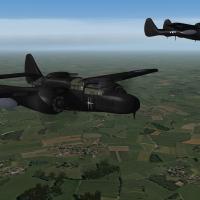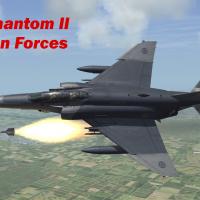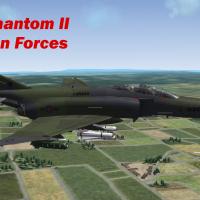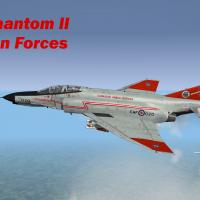-
Content count
11 -
Joined
-
Last visited
Community Reputation
2 NeutralAbout Sabre103

Profile Information
-
Gender
Male
-
Location
Canada
-
-
-
- canadian forces
- cf
-
(and 8 more)
Tagged with:
-
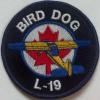
CF/RCAF squadron markings
Sabre103 replied to Sheriff001's topic in Thirdwire: Strike Fighters 2 Series - Mods & Skinning Discussion
Just downloaded the packs last week when they came out, and they are fantastic. Great work, Sheriff! Thanks! -

Have you guys noticed...
Sabre103 replied to Carlos_Tex's topic in Thirdwire: Strike Fighters 2 Series - General Discussion
Sorry, Crazyhorse, no offence intended. Just trying to be funny, but probably missed the mark...it occurred to me at the time it was kind of a silly, stereotypical remark and I considered taking it down but the post was already up there. -

Have you guys noticed...
Sabre103 replied to Carlos_Tex's topic in Thirdwire: Strike Fighters 2 Series - General Discussion
Something tells me that anything with "Strike Fighters" in the title isn't likely to appeal to many hipsters either way... -

CF/RCAF squadron markings
Sabre103 replied to Sheriff001's topic in Thirdwire: Strike Fighters 2 Series - Mods & Skinning Discussion
Really nice work, looking forward to seeing the rest. The SEA markings look great. Makes perfect sense, especially if the backstory assumes McDonnell-Douglas built aircraft without any kind of license production, all the more so if some were taken out of USAF stocks second-hand... As for arctic patches on the Hill Grey, if I may put in the proverbial 2 cents, for whatever it's worth...the CF-18 fleet has handled the NORAD role for 30 years in a very similar scheme without ever receiving arctic rescue markings, and the CF-101 fleet often went without them in the old Voodoo Grey scheme. That being said, they do look awesome on that early CF-4 scheme... Really like the idea of 414 as an F-4G unit. Would 419 Moose work as an alternative to some of the other squadrons you couldn't find insignia for? They were a CF-100 squadron in the 50s and re-formed on CF-5s from the late 60s up to '95 and are now a CT-155 Hawk lead-in fighter training squadron...they'd be a pretty plausible operator for the CF-4. The problem I've found looking for 434 insignia is that every fast jet they operated (Sabre, CF-5, T-33) had the tailband style of insignia, which doesn't fit with the CF-101 / CF-104-stlye presentation on your schemes...and unlike the other squadrons their flightsuit patch doesn't really look like what went on the aircraft. Maybe some variation on this flash could be of some use? I don't know... -

CF/RCAF squadron markings
Sabre103 replied to Sheriff001's topic in Thirdwire: Strike Fighters 2 Series - Mods & Skinning Discussion
Great stuff! That is a beautiful sight...thank you for making it happen. -

CF/RCAF squadron markings
Sabre103 replied to Sheriff001's topic in Thirdwire: Strike Fighters 2 Series - Mods & Skinning Discussion
Right you are, I do apologize... I'm used to the fighter schemes to the point that it looked wrong when I noticed it -which took a while- and didn't bother to check references (even the one I just linked above, d'oh!). Live and learn... Awesome. I saw your CR-110 screenshots in the What-If screenshots thread, they look great...I really like the look of the Euro 1 scheme with CF markings, especially on a Phantom. As a side note, I remember the earlier version of Patrick Martin's book had brief details of a three-tone wraparound scheme that was proposed but never adopted for the NATO-assigned CF-18s in the late 80s when FIP markings were being introduced which, IIRC, looked very similar to Euro 1. -

changing names on pilot roster?
Sabre103 replied to MrGoTime's topic in Thirdwire: Strike Fighters 2 Series - Mods & Skinning Discussion
Thanks, Wrench. I did open them all, no sign of name lists... Glad it's not just me...my old hard drive has an install at an early 2010 patch level on it, I'll see if I can track them down there... Thanks again! -

CF/RCAF squadron markings
Sabre103 replied to Sheriff001's topic in Thirdwire: Strike Fighters 2 Series - Mods & Skinning Discussion
Looking great! Are you planning to include any camo NATO schemes prior to the low-viz grey in the package? I hope you don't mind such nitpicking comments, but I did notice a couple more minor points I thought were worth mentioning even though it took me a while to notice them: -The FIP era (current style with the Canada wordmark) markings would have just a plain roundel, not the roundel-ident with ARMED FORCES / FORCES ARMEES on either side (the signature takes the place of these titles on the FIP scheme). -The early CAF style markings with English titling on the left and French on the right wouldn't have the last-three of serial on the nose, since it's next to the roundel opposite the "CAF". -Finally, the half-flag on the signature would probably be red on an aircraft with full-colour markings (though there are enough small exceptions to the rules of CF aircraft markings that I'd consider the all-black version plausible: e.g. SAR CH-146 Griffons have red lettering for the Canada wordmark and the flag was left off of the wordmark on tactical camo Griffons and maybe one or two schemes other schemes, so a Phantom with an all-black signature on full colour markings fits well enough). I agree that the signature between the intake and leading edge wing root looks best. As far as I can tell there's no real "rule" as to its position, just whatever looks best for the airframe and not too near the roundel. It's near the tail on the CF-18, but then the Hornet has the roundel on the forward fuselage in a position that would look rather strange on a Phantom (at least to my mind, and even allowing for some approximation since the exact same position would probably put it on the F-4's splitter plate). Also agree about the Voodoo Grey - before you posted the screenshots I'd been about to say the ADC Gray was close enough but it does have a different look to it and it fits the scheme well. -

changing names on pilot roster?
Sabre103 replied to MrGoTime's topic in Thirdwire: Strike Fighters 2 Series - Mods & Skinning Discussion
Sorry for being so dense, but where is namesus.lst located? I've looked through the CAT files using the Extractor and all that shows up for the /Flight folder are FlightData.cat, FlightText.cat, MissionData001 to 007.cat and MissionText001 to 007.cat. None of them contain any names[x].lst files as far as I can tell. I've looked through the Menu .cat files and can't seem to find them there, either... If anyone could please point me in the right direction it would be much appreciated, thanks. -

CF/RCAF squadron markings
Sabre103 replied to Sheriff001's topic in Thirdwire: Strike Fighters 2 Series - Mods & Skinning Discussion
You're welcome, sorry I couldn't offer anything more concrete... Looks good to me, the only thing I'd suggest is moving "Canadian Forces" and "Forces Canadiennes" a bit closer together. The gap between them should only be a tiny bit wider (sorry I can't be more precise than that) than the one between the flag and "Canadian Forces," which looks pretty well spot on there. Arial looks like a good match on the font, (according to Canadian Military Aircraft Finish and Markings 1968-2004 by Patrick Martin, the original font was Helvetica, so definitely close enough). For what it's worth, according to the same source, the original "half flag" signature was used from 1984 with the introduction of FIP era markings, up until 1990. A minor point to note on that one was that, aside from the missing right bar on the flag, the leaf was 109% of the height of the bars (as opposed to 89% on the version of the signature with the full flag). The full flag version was introduced in 1990 and from 1999 the letters were made thicker (using bold would capture it just about right, judging by the diagrams). Having said that, going by my references, the half flag version has stuck around for a long time and there may well still be a few CF-18s and possibly other types that haven't been repainted with the newer version. -

CF/RCAF squadron markings
Sabre103 replied to Sheriff001's topic in Thirdwire: Strike Fighters 2 Series - Mods & Skinning Discussion
Great work! I saw the screenshots in the What-If thread and was meaning to reply. I've always liked the idea of a CF-4 and am very much looking forward to the release of this pack. I'm afraid I don't have anything in the appropriate file format and the only images I have are too low-res in any case. Leading Edge Models does produce some good scale model decal sheets that might be a useful reference to work from for 414, 421 and 434. I don't know if that helps at all or not... If you'll forgive one minor nitpick, though: The roundel should be on the upper side of both the left and right wings, with CAF under the lower right and the last three of serial under the lower left for "Symmetrical" era markings (ca. 1973-1983, though implementation of the new FIP era markings was sometimes slow -I'm only aware of one of the CF-18s that participated in Desert Storm having had FIP era markings-). The upper left/lower right roundel and upper right/lower left last three of serial came in with the "FIP" era markings. This link summarizes the development of post-WWII RCAF/CF markings quite nicely: http://www.canmilair.com/schemes.htm

